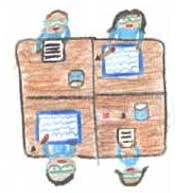Articles
 The resources listed are intended to provide a starting point for using drawings in science education research and for those who are interested in learning more about the findings from the Project Nexus teacher education project. For a more exhaustive list of sources please consult the reference lists of our individual publications.
The resources listed are intended to provide a starting point for using drawings in science education research and for those who are interested in learning more about the findings from the Project Nexus teacher education project. For a more exhaustive list of sources please consult the reference lists of our individual publications.
Katz, P., McGinnis, J. R., Hestness, E., Riedinger, K., Marbach-Ad, G., Dai, A., et al. Professional Identity Development of Teacher Candidates Participating in an Informal Science Education Internship: A focus on drawings as evidence. International Journal of Science Education, 33(9), 1169-1197.
Katz, P., McGinnis, J. R., Riedinger, K., Dai, A., & Pease, R. (2011). Professional Identity Development of beginning Elementary Teachers of Science: A Comparative Case Study. An interactive poster presented at the annual meeting of the National Association for Research in Science Teaching (NARST), Orlando, FL, April 3 - 6, 2011.
Hestness, E. McGinnis, J. R., Riedinger, K., & Marbach-Ad, G. (2011). A study of teacher candidates’ experiences investigating global climate change education within an elementary science methods course. Journal of Science Teacher Education, v22, 351-369. DOI: 10.1007/s10972-011-9234-2.
McGinnis, J. R., Hestness, E., Riedinger, K., Katz, P., Marbach-Ad, G. & Dai, A. (in press). Informal science education in formal science teacher education. In K. Tobin, B. Frasier, & C. McRobbie (Eds.), Second international handbook of science education. The Netherlands: Kluwer.
Additional Resources (Non-Project Nexus Publications)
Carnes, N. (2009). Interpreting drawings of preservice teachers. In J. E. Pederson & K. D. Finson (Eds.), Visual Data. Rotterdam, 79-92.
Driver, R., Leach, J., Millar, R., & Scott, P. (1983). Young people's images of science. Philadelphia, PA: Open University Press.
Eick, C. J. (2009). Tailoring national standards to early science teacher identities: Building on personal histories to support beginning practice. Journal of Science Teacher Education, 20, 135-156.
Finson, K. D. (2001). Investigating preservice elementary teachers' self-efficacy relative to self image as a science teacher. Journal of Elementary Science Education, 13(1), 31-42.
Gee, J. P. (2001). Identity as an analytic lens for research in education. Review of Research in Education, 25, 99-125.
Luehmann, A. L. (2007). Identity development as a lens to science teacher preparation. Science Education, 91(5), 822-839.
Mead. M., & Metraux. R. (1957). The image of the scientist among high school students: A pilot study. Science, 126, 384-390.
National Research Council. (2007). Taking Science to School. Washington, D.C.: The National Academies Press.
National Research Council (2009). Learning Science in Informal Environments. Washington, D.C.: National Academies Press.
Schibeci, R.A. (1986). Images of science and scientists and science education. Science Education, 70,2, 139-149.
Sfard, A., & Prusak, A. (2005). Telling identities: In search of an analytic tool for investigating learning as a culturally shaped activity. Educational Researcher, 34(4), 14-22.
Symington, D. and Spurling, H. (1990). The draw-a-scientist test: Interpreting the data. Research in Science and Technological Education, 8, 75-77
Thomas, J. A., Pedersen, J.E., and Finson, K. (2001). Validating the Draw-A-Science-Teacher-Test Checklist (DASTT-C): Exploring Mental Models and Teacher Beliefs. Journal of Science Teacher Education, 12(3), 295-310.
Weber, S., & Mitchell, C. (1995). "That's Funny, You Don't Look Like A Teacher". Interrogating Images and Identity in Popular Culture. Philadelphia, PA: The Falmer Press, Taylor & Francis, Inc.
Visit our publications page for a complete list of Project Nexus publications and presentations.

